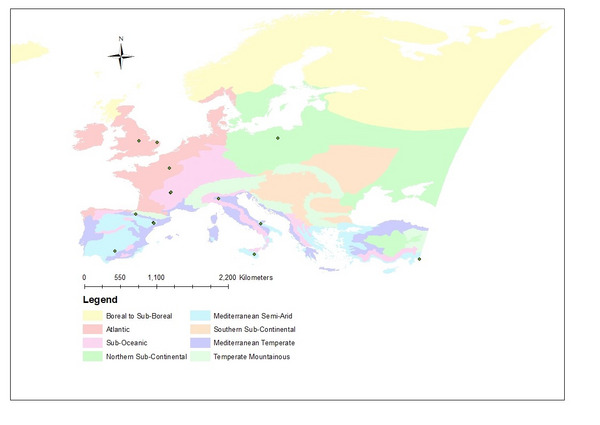The analyses included 189 pairs of data concerning grain yield response to different nitrogen fertilization rates in different field trials of wheat across Europe. The data was taken between 1995 and 2008 and covers 5 different climatic regions (figure 1) and 3 different soil types.
The correlation between grain yield and nitrogen fertilization rates was positive with a coefficient of determination (R²) of 0.247. In 1995 and 1996, an increase in nitrogen fertilization did not necessarily resulted in higher yields, while in 2001, 2004 and 2008 the grain clearly responded to the nitrogen input. This possibly highlights the influence of rain and temperature, which was variable during these periods. In situations where wheat growth was limited by any abiotic factor, it did not benefit from extra nitrogen fertilization input. Further analysis should take into account the average annual rain and temperature registered during these periods to understand these limitations.
This is also the case for the influence of different climatic regions on the nitrogen fertilization impact on grain yield. Results show that in Mediterranean, Semi-Arid and Northern Sub-Continental regions, the grain yield of wheat responded linearly to the nitrogen fertilization rate, but it should be taken into account that this analysis did not include a significant amount of data from different years, where the rain and temperature were variable.
Finally, there was also a correlation between the soil type and the grain response to different nitrogen doses. This should also be extended to obtain data from different trials where other soil types were present. The grain response should be correlated with different soil characteristics that might be involved in the nitrogen biological and non-biological processes occurring in the soil that impact the nitrogen uptake by the wheat.
Future work therefore includes:
- collecting more data from nitrogen fertilization rates and the corresponding effects on grain yield in other locations in Europe;
- additional collection of meteorological and pedological data as well as different management options, fertilization timing and soil characteristics and;
- a meta-analysis including all of these factors to understand which limitations affect the grain response to nitrogen fertilization.

 tap and then scroll down to the Add to Home Screen command.
tap and then scroll down to the Add to Home Screen command.